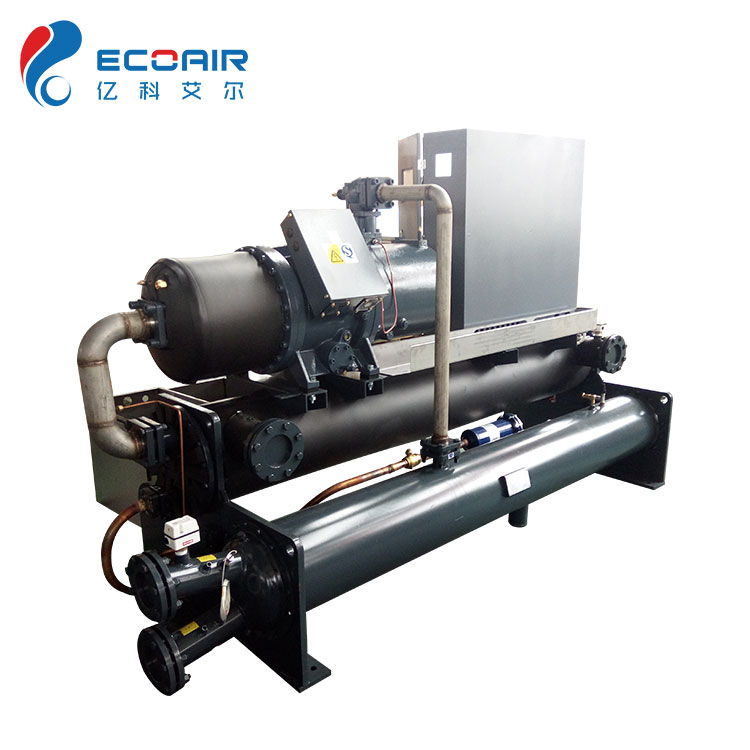Key Components of a Water-Cooled Chiller
2024-06-05
A water-cooled chiller is a type of refrigeration system that uses water as the cooling medium to remove heat from a process or space. These chillers are commonly used in large commercial, industrial, and institutional facilities where consistent and efficient cooling is required. Here's a detailed overview of water-cooled chillers, including their components, operation, advantages, applications, and maintenance considerations.
Key Components of a Water-Cooled Chiller
1. Compressor: The heart of the chiller, responsible for compressing the refrigerant and circulating it through the system. Common types include centrifugal, screw, scroll, and reciprocating compressors.
2. Evaporator: A heat exchanger where the refrigerant absorbs heat from the water, cooling it before it's circulated to the process or space.
3. Condenser: Another heat exchanger where the refrigerant releases absorbed heat to the cooling water, which is then sent to a cooling tower.
4. Expansion Valve: Controls the flow of refrigerant into the evaporator, reducing its pressure and allowing it to absorb heat.
5. Cooling Tower: A device that removes heat from the cooling water by evaporation, typically located outside the building.
6. Pumps: Circulate the chilled water to the process or space and the cooling water to the cooling tower.
7. Control System: Monitors and regulates the operation of the chiller, ensuring optimal performance and energy efficiency.
Operation of a Water-Cooled Chiller
1. Heat Absorption: Warm water from the process or space flows into the evaporator, where it transfers its heat to the refrigerant, cooling the water.
2. Refrigerant Compression: The heated refrigerant vapor is compressed by the compressor, increasing its pressure and temperature.
3. Heat Rejection: The hot, high-pressure refrigerant flows into the condenser, where it releases its heat to the cooling water.
4. Cooling Water Cycle: The heated cooling water is pumped to the cooling tower, where it releases the absorbed heat to the atmosphere.
5. Refrigerant Expansion: The high-pressure refrigerant is expanded through the expansion valve, reducing its pressure and temperature before entering the evaporator again.
Advantages of Water-Cooled Chillers
- Energy Efficiency: Generally more energy-efficient than air-cooled chillers, especially in large-scale applications.
- Longevity: Typically have a longer lifespan due to lower operating pressures and temperatures.
- Consistent Performance: Provide consistent cooling performance, even in high ambient temperatures.
- Quiet Operation: Tend to be quieter than air-cooled systems, as the cooling tower is usually located outside.
Applications of Water-Cooled Chillers
- Commercial Buildings: Office buildings, shopping malls, and hotels for air conditioning.
- Industrial Facilities: Manufacturing plants, data centers, and laboratories for process cooling.
- Institutional Buildings: Hospitals, universities, and research facilities for both comfort and process cooling.
- District Cooling Systems: Centralized cooling plants that serve multiple buildings or facilities.
Maintenance Considerations for Water-Cooled Chillers
1. Regular Inspections: Routine checks of all components, including compressors, evaporators, condensers, and pumps.
2. Water Treatment: Regular water treatment to prevent scaling, corrosion, and biological growth in the cooling tower and water circuit.
3. Cleaning: Periodic cleaning of the evaporator and condenser tubes to maintain efficient heat transfer.
4. Lubrication: Ensuring that moving parts such as compressor bearings and motor shafts are adequately lubricated.
5. Refrigerant Levels: Monitoring and maintaining proper refrigerant levels to ensure optimal performance.
6. Control System Calibration: Regular calibration of sensors and control systems to ensure accurate operation.
7. Energy Audits: Conducting periodic energy audits to identify opportunities for improving efficiency and reducing operating costs.
Common Challenges and Solutions
- Water Quality Issues: Implement a robust water treatment program to prevent scaling and corrosion.
- Energy Consumption: Optimize chiller operation through variable speed drives and advanced control strategies.
- Component Wear: Regular maintenance and timely replacement of worn parts to prevent breakdowns.
- Environmental Impact: Use environmentally friendly refrigerants and optimize system efficiency to reduce the carbon footprint.
By understanding these components and considerations, facilities can effectively utilize water-cooled chillers to provide efficient and reliable cooling for various applications.



